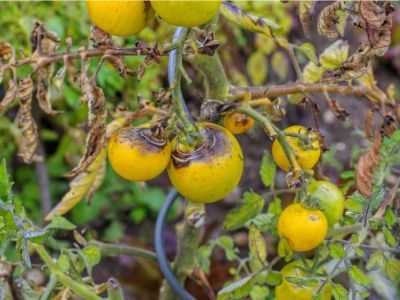There are too many tomato plant diseases to list in one article, and the truth is many of them fall under the same types or categories of disease. In tomato plants in the home garden, the type or category and its symptoms are more important than the individual bacteria or virus, which can only be diagnosed through a professional laboratory. The following list of tomato diseases and their descriptions are broken into three categories.
List of Tomato Diseases
Fungus Based Tomato Plant Diseases
This first list of tomato diseases are caused by fungi. Fungal attacks are probably the most common of tomato diseases. Easily transferred by air or physical contact, the spores can lay dormant through the winter to attack again when the weather warms. Blights – Early blight begins as small black lesions on the leaves and soon forms concentric rings like a target. This tomato disease’s telltale mark is found at the stem end of the fruit which will turn black. Late blight usually occurs when late-season temperatures cool and dew is heavy, with dark water-soaked spots on the leaves. The fully formed fruit rots on the vine before it fully ripens. Wilts – Fusarium wilt is distinctive among tomato plant diseases because it begins by attacking only one half of the leaf and takes over one side of the plant before it moves to the other. Leaves will yellow, wilt, and fall. Verticillium wilt presents with the same leaf symptom but attacks both sides of the plant at once. Many hybrids are resistant to these two tomato plant diseases. Anthracnose – Anthracnose is a common disease in tomato plants. It demonstrates as small circular, bruised spots on the skin that invite other fungi to infect the interior of the fruit. Molds and Mildews – These should be included in any list of tomato diseases. They are found where plants are closely planted and air circulation is poor and will normally look like a powdery substance on the leaves.
Virus Based Diseases of Tomato Plants
Viruses are the second most common in diseases of tomato plants. There are a half dozen or more mosaic viruses that make the botanist’s list of tomato diseases. Mosaics cause stunted growth, deformed fruit, and leaves mottled with colors in grays, browns, greens, and yellows. Tomato leaf curl appears as it sounds; green leaves are curled and deformed.
Bacterial Based Disease in Tomato Plants
Bacteria are next on our list of tomato diseases. Bacterial spot – Raised black spots surrounded by a yellow halo that eventually scab over indicates bacterial spot, a disease in tomato plants that can reside in the seed. Bacterial speck – Less destructive is bacterial speck. Its much smaller scabs rarely penetrate the skin and can be scraped off with a fingernail. Bacterial wilt – Bacterial wilt is another devastating tomato plant disease. The bacteria enter through damaged roots and clog the water carrying system with slime as it multiplies. The plants wilt, literally, from the inside out.
Environmental Issues in Tomato Plants
While often a problem, blossom end rot isn’t found among the diseases of tomato plants. Blossom end rot is, in fact, not a disease at all, but a condition caused by a calcium deficiency in the fruit usually caused by extreme fluctuations in moisture.
